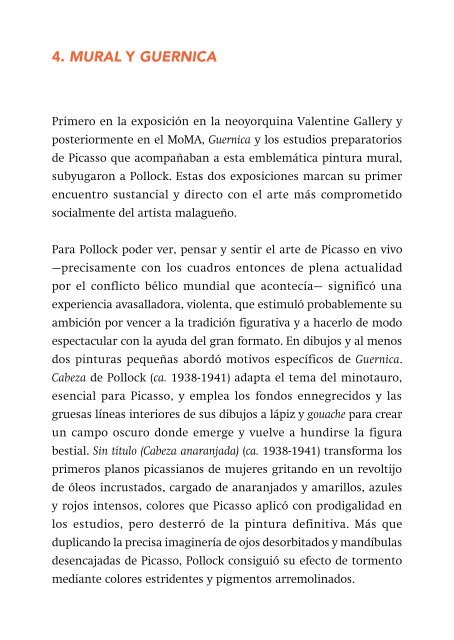MURAL JACKSON POLLOCK
cuadernillo_Jackson_Pollock
cuadernillo_Jackson_Pollock
You also want an ePaper? Increase the reach of your titles
YUMPU automatically turns print PDFs into web optimized ePapers that Google loves.
4. <strong>MURAL</strong> Y GUERNICA<br />
4. <strong>MURAL</strong> AND GUERNICA<br />
Primero en la exposición en la neoyorquina Valentine Gallery y<br />
posteriormente en el MoMA, Guernica y los estudios preparatorios<br />
de Picasso que acompañaban a esta emblemática pintura mural,<br />
subyugaron a Pollock. Estas dos exposiciones marcan su primer<br />
encuentro sustancial y directo con el arte más comprometido<br />
socialmente del artista malagueño.<br />
Para Pollock poder ver, pensar y sentir el arte de Picasso en vivo<br />
—precisamente con los cuadros entonces de plena actualidad<br />
por el conflicto bélico mundial que acontecía— significó una<br />
experiencia avasalladora, violenta, que estimuló probablemente su<br />
ambición por vencer a la tradición figurativa y a hacerlo de modo<br />
espectacular con la ayuda del gran formato. En dibujos y al menos<br />
dos pinturas pequeñas abordó motivos específicos de Guernica.<br />
Cabeza de Pollock (ca. 1938-1941) adapta el tema del minotauro,<br />
esencial para Picasso, y emplea los fondos ennegrecidos y las<br />
gruesas líneas interiores de sus dibujos a lápiz y gouache para crear<br />
un campo oscuro donde emerge y vuelve a hundirse la figura<br />
bestial. Sin título (Cabeza anaranjada) (ca. 1938-1941) transforma los<br />
primeros planos picassianos de mujeres gritando en un revoltijo<br />
de óleos incrustados, cargado de anaranjados y amarillos, azules<br />
y rojos intensos, colores que Picasso aplicó con prodigalidad en<br />
los estudios, pero desterró de la pintura definitiva. Más que<br />
duplicando la precisa imaginería de ojos desorbitados y mandíbulas<br />
desencajadas de Picasso, Pollock consiguió su efecto de tormento<br />
mediante colores estridentes y pigmentos arremolinados.<br />
Pollock was held spellbound by Guernica and the preparatory<br />
studies by Picasso that accompanied this emblematic mural<br />
painting when it was displayed first at New York’s Valentine<br />
Gallery and later at the Museum of Modern Art. These two<br />
exhibitions marked the American’s first direct and substantial<br />
encounter with the most socially committed work of the Málagaborn<br />
artist.<br />
For Pollock, the opportunity to see, think and feel Picasso’s<br />
art at first hand during the Second World War, precisely when<br />
the pictures were at their most topical, was an overpowering<br />
experience, and it probably stimulated his ambition to surpass<br />
figurative tradition in spectacular fashion with the aid of large<br />
formats. He focused on specific motifs from Guernica in some<br />
drawings and at least two small paintings. Pollock’s Head (c. 1938–<br />
41) adapts the theme of the Minotaur, essential for Picasso, and<br />
uses the blackened backgrounds and thick interior lines of his<br />
pencil and gouache drawings to create a dark field from which the<br />
bestial figure emerges only to sink back in again. Untitled (Orange<br />
Head) (c. 1938–41) transforms the screaming women of Picasso’s<br />
foregrounds into a tangle of incrusted oils laden with oranges,<br />
yellows, blues and intense reds, colours which Picasso applied<br />
liberally in his studies but omitted from the final painting. Rather<br />
than duplicating Picasso’s precise imagery of wide-open jaws and<br />
eyes straining from their sockets, Pollock achieved his effect of<br />
torment through strident colours and a welter of pigments.


